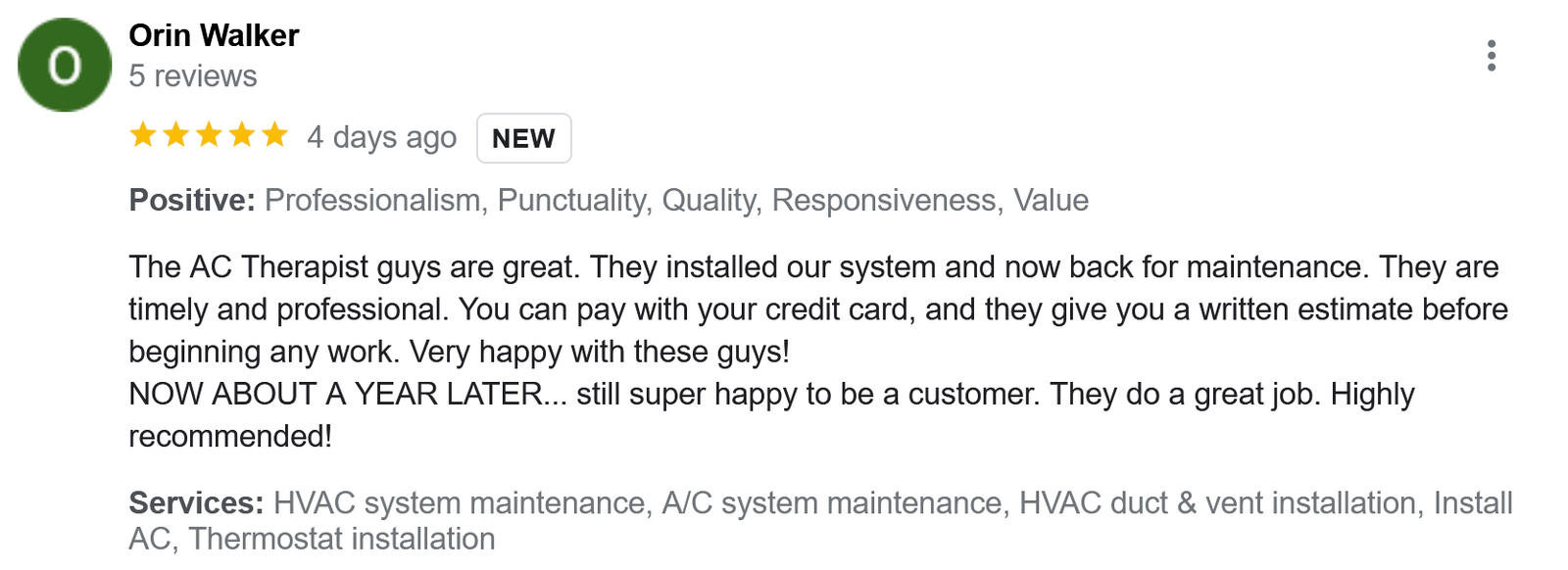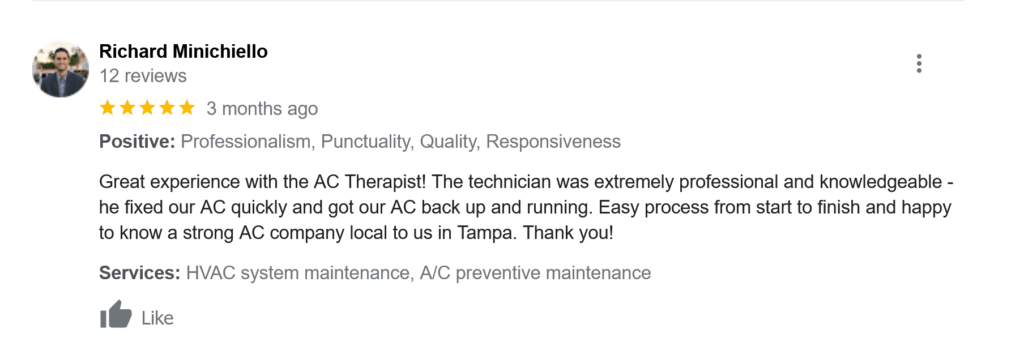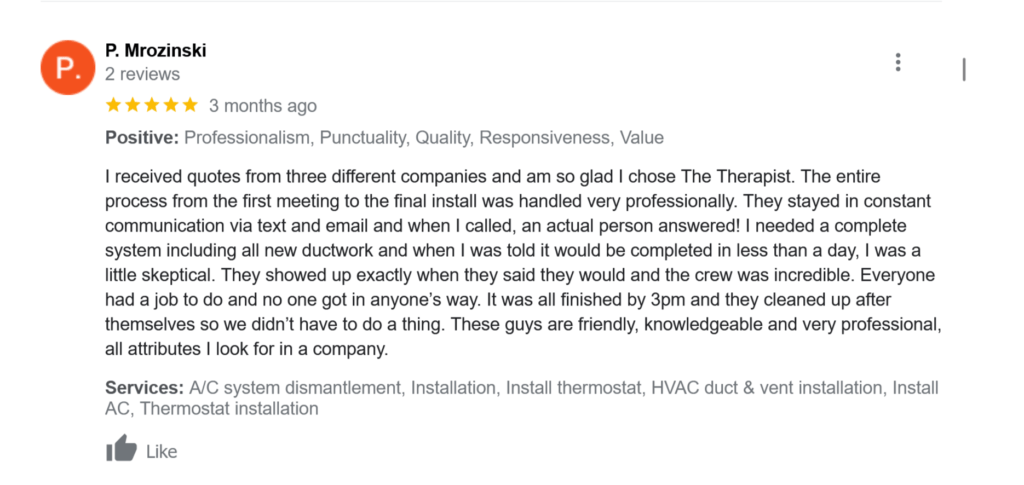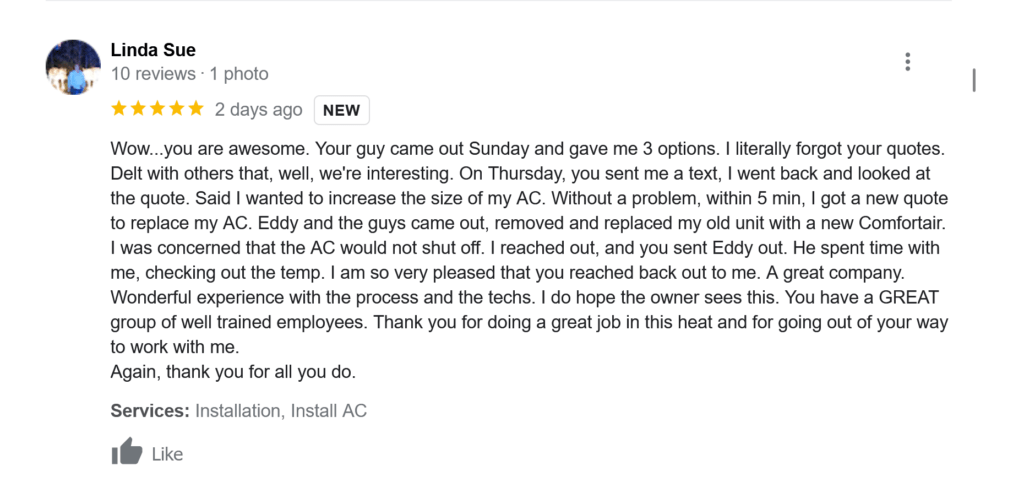Furnace Repair
When your furnace starts acting up, turn to The AC Therapist for swift, professional furnace repair services. Our experienced team in Tampa Bay is well-equipped to tackle any furnace issue, ensuring your home stays warm and cozy. With our deep commitment to customer satisfaction, we provide solutions that last, getting your furnace back in peak condition quickly and efficiently.

Furnace Repair in Tampa Bay
Comprehensive Furnace Repair Services: Solving Common Problems with Expert Solutions at The AC Therapist
Your furnace is a critical part of your home’s comfort system, and when it starts showing signs of trouble, it can be a cause for concern. The AC Therapist is your trusted partner for expert furnace repair services in the Tampa Bay area. Here, we’ll discuss some common furnace problems, their potential solutions, and why we’re the best in the area to handle your needs:
No Heat or Insufficient Heat: This can be due to a variety of issues like a malfunctioning thermostat, clogged filters, or problems with the pilot light. Our technicians can diagnose the exact problem and fix it promptly to restore your home’s warmth.
Frequent Cycling: If your furnace turns on and off frequently, it could signal an improper airflow, a thermostat issue, or a clogged filter. We can address these problems, ensuring your furnace operates efficiently.
Blower Continuously Runs: This could indicate a problem with the limit switch, which we can replace for you to restore normal functioning.
Unusual Noises: Rattling, humming, or squeaking noises from your furnace can indicate mechanical problems. Our team can accurately identify and rectify these issues, reducing potential damage to your system.
Ignition or Pilot Control Problems: A faulty ignition or pilot could make it difficult to heat a home or commercial space. Our experts can troubleshoot these issues, offering reliable solutions.
Why The AC Therapist is the Best Choice:
Experienced and Certified Technicians: Our team comprises seasoned professionals with the skills to handle a wide range of furnace issues. They undergo regular training to stay updated with the latest HVAC technology and best practices.
Customer-Oriented Service: We place our customers’ comfort and satisfaction at the center of our services. We respond promptly to your calls and work diligently to restore your furnace’s functionality as soon as possible.
Transparent Pricing: We maintain transparency in our pricing, providing you with detailed quotes before we commence any repair work.
24/7 Emergency Services: We are available round the clock for emergency furnace repairs, ensuring you never have to endure the discomfort of a cold home.
Local Experience: As a local business, we understand the specific needs of Tampa Bay residents and offer tailored solutions that best suit your needs.
Trust The AC Therapist for all your furnace repair needs. Our commitment to quality service and customer satisfaction sets us apart in the Tampa Bay area.
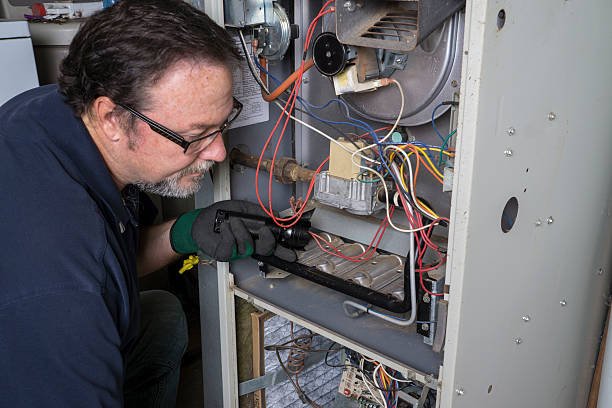

Why Choose The AC Therapist?
The AC Therapist is not only committed to providing the best Furnace Repair services, but also providing the right education to homeowners on how to best handle their HVAC units so that small problems do not become larger and more costly issues down the line.
We proudly serve those in the Hillsborough, Pasco, and Pinellas County for over ten years. If you would like more information, feel free to give them a call at (813)-343-2212 or you can book online and get their latest discount!
No Hidden or Unexpected Charges
Free Estimates & Online Booking Available
Professionally Trained Technicians
Honesty is Guaranteed
Quick Communication & Service Within 24 Hours
400+ 5 Star Reviews
Your questions answered
Common Furnace Repair Questions:
What are the most common furnace problems?
The most common furnace problems that homeowners may encounter include:
Lack of maintenance: Failure to perform regular maintenance, such as cleaning or replacing air filters, can lead to reduced efficiency and performance issues.
Ignition problems: Furnaces may experience issues with the ignition system, such as a faulty pilot light or a malfunctioning electronic ignition, resulting in the furnace not starting or producing heat.
Thermostat malfunctions: Problems with the thermostat can lead to inaccurate temperature readings or the furnace not responding to temperature adjustments properly.
Blower motor issues: A malfunctioning blower motor can result in reduced airflow, inadequate heat distribution, or even complete system failure.
Clogged or dirty air filters: If air filters become clogged or dirty, it restricts airflow, forcing the furnace to work harder, reducing efficiency, and potentially causing overheating issues.
Faulty limit switch: The limit switch is responsible for turning off the furnace when the desired temperature is reached. A faulty limit switch may cause the furnace to overheat or shut off prematurely.
Pilot light or flame sensor problems: If the pilot light goes out or the flame sensor is dirty or malfunctioning, the furnace may not ignite or may continuously cycle on and off.
Gas supply issues: Problems with the gas supply, such as a closed gas valve or a gas leak, can prevent the furnace from igniting or cause safety concerns.
Excessive noise: Unusual noises, such as rattling, squealing, or banging sounds, may indicate issues with components like the blower motor, belts, or bearings.
Age-related wear and tear: Over time, furnaces can experience general wear and tear, leading to decreased efficiency and increased likelihood of component failure.
It’s important to address these issues promptly by contacting a qualified HVAC professional to diagnose and repair the problem, ensuring the safe and efficient operation of your furnace.
What is the most expensive repair on a furnace?
The most expensive repair on a furnace typically involves the replacement of the heat exchanger. The heat exchanger is a crucial component of a furnace responsible for transferring heat from the combustion process to the surrounding air. Over time, due to factors such as age, wear and tear, or poor maintenance, the heat exchanger can develop cracks or other forms of damage.
Repairing or replacing a heat exchanger can be a costly process. In some cases, if the furnace is relatively old or if the heat exchanger is severely damaged, it may be more cost-effective to replace the entire furnace rather than just the heat exchanger.
Replacing a heat exchanger requires specialized skills and expertise. It involves disassembling the furnace, removing the damaged heat exchanger, and installing a new one. The process can be labor-intensive and time-consuming, contributing to the overall expense of the repair.
It’s important to note that the cost of a heat exchanger replacement can vary depending on factors such as the type and size of the furnace, the availability of parts, and local labor rates. Additionally, some manufacturers offer warranty coverage specifically for heat exchangers, which may help offset the cost of repairs in certain cases.
If you suspect a problem with your heat exchanger or any other significant issue with your furnace, it is recommended to contact a qualified HVAC professional. They can assess the situation, provide an accurate diagnosis, and offer guidance on the most suitable and cost-effective repair or replacement options for your furnace.
What is the life expectancy of a new furnace?
The life expectancy of a new furnace can vary depending on several factors, including the quality of the unit, the manufacturer, how well it is maintained, and the operating conditions. However, on average, a well-maintained furnace can last between 15 to 20 years.
High-quality furnaces that receive regular maintenance and operate under normal conditions can often reach the upper end of this range. However, some factors may impact the lifespan of a furnace:
Maintenance: Regular maintenance, such as annual inspections, filter changes, and cleaning, can help extend the lifespan of a furnace by ensuring optimal performance and addressing potential issues before they become major problems.
Installation quality: Proper installation by a qualified HVAC professional is crucial for the longevity of a furnace. Incorrect installation can lead to premature wear and inefficient operation.
Usage patterns: The frequency and duration of furnace use can impact its lifespan. Furnaces that operate constantly or experience extended periods of heavy use may have a shorter lifespan compared to those used more sparingly.
Climate: The climate in which the furnace operates can influence its lifespan. Extreme temperature variations or prolonged periods of heavy use may put additional strain on the system, potentially affecting its longevity.
Maintenance history: If a furnace has a history of poor maintenance or neglect, its lifespan may be shorter. Lack of maintenance can lead to issues such as component failures, reduced efficiency, and overall system degradation.
It’s important to note that these are general guidelines, and individual circumstances can vary. Regular maintenance, prompt repairs, and following manufacturer recommendations can help maximize the lifespan of a furnace. If you have concerns about the lifespan of your furnace, it’s recommended to consult with a qualified HVAC professional who can assess the unit and provide guidance based on its specific condition.
What would cause a furnace not to kick on?
Several factors can cause a furnace not to kick on or start. Some common reasons include:
Thermostat settings: Check the thermostat to ensure it is set to the desired temperature and is in the “heat” mode. If the thermostat has a low battery, replace it.
Power supply issues: Make sure the furnace is receiving power. Check the circuit breaker or fuse box to ensure the circuit is not tripped or the fuse is not blown.
Ignition problems: If you have a gas furnace, ignition problems may prevent it from starting. This could be due to a faulty pilot light, ignition control module, or electronic ignition system.
Gas supply issues: If there is no gas supply or a gas valve is closed, the furnace won’t ignite. Ensure the gas valve is open and the gas supply is functioning correctly.
Dirty air filter: A clogged or dirty air filter can restrict airflow, causing the furnace to shut off as a safety measure. Check the air filter and replace it if needed.
Blocked exhaust vent: A blocked exhaust vent can cause the furnace to shut down for safety reasons. Clear any debris or obstructions from the vent.
Malfunctioning limit switch: The limit switch is a safety feature that shuts off the furnace if it overheats. If the limit switch is faulty, it may prevent the furnace from starting.
Blower motor issues: Problems with the blower motor, such as a faulty motor or a broken belt, can prevent the furnace from starting.
Control board or thermostat issues: Faulty control boards or malfunctioning thermostats can prevent the signal from reaching the furnace, resulting in a failure to start.
If your furnace does not kick on, it’s recommended to contact a qualified HVAC professional for diagnosis and repair. They have the expertise and tools to identify the specific cause and provide the necessary repairs to get your furnace up and running again safely.
How Much Does The Average Furnace Repair Cost?
The cost of furnace repair can vary depending on several factors, including the specific problem, the extent of the repair needed, the location, and the HVAC service provider. However, to provide a general idea, the average cost of furnace repair typically ranges between $150 and $500.
Minor repairs, such as replacing a faulty thermostat or ignitor, usually fall on the lower end of the price range. On the other hand, more significant repairs, such as fixing a blower motor or replacing a heat exchanger, can be more expensive and may fall on the higher end of the range.
It’s important to note that these are rough estimates, and the actual cost may differ based on the specific circumstances of the repair. Factors such as the type and age of the furnace, accessibility of components, and any necessary replacement parts can also influence the final cost.
Additionally, emergency or after-hours repairs may incur higher costs due to the urgency and availability of service technicians.
To obtain an accurate estimate for your specific furnace repair, it is recommended to contact a reputable HVAC professional. They can assess the issue, provide a detailed diagnosis, and offer a fair and transparent cost estimate for the necessary repairs.
When Do You Need Furnace Repair?
You may need furnace repair if you encounter any of the following signs or issues:
Insufficient heat: If your furnace is not providing enough heat or if the temperature in your home remains consistently low despite the system running, it indicates a problem that requires repair.
No heat at all: If your furnace fails to produce any heat when it should be operational, it suggests a malfunction that needs to be addressed.
Unusual noises: Loud bangs, squealing, rattling, or grinding noises coming from your furnace can indicate mechanical issues, such as a faulty blower motor, loose components, or worn-out belts, which require repair.
Frequent cycling: If your furnace turns on and off frequently, known as short cycling, it may be due to issues with the thermostat, airflow restrictions, or an overheating system, necessitating repair.
High energy bills: A sudden and unexplained increase in your energy bills could be a sign of an inefficient furnace that needs attention. Inefficient operation can result from various issues, such as clogged filters, airflow problems, or component failures.
Poor indoor air quality: If you notice an increase in dust, excessive dryness, or respiratory discomfort, it could be a result of a malfunctioning furnace or dirty components that require cleaning or repair.
Yellow or flickering burner flame: A burner flame should be consistently blue. If you observe a yellow or flickering flame, it may indicate a combustion problem, such as a gas leak or incomplete burning, which necessitates immediate attention for safety reasons.
Strange odors: Unusual odors, such as a burning smell or a strong musty odor, coming from the furnace can indicate problems that require professional assessment and repair.
It’s essential to address furnace issues promptly to prevent further damage, ensure safe operation, and maintain optimal efficiency. If you notice any of these signs or encounter other concerns with your furnace, it is recommended to contact a qualified HVAC professional who can diagnose the problem and provide the necessary repairs.
Furnace Repair Cost Breakdown
The cost breakdown of furnace repair typically includes the following components:
Diagnostic fee: HVAC technicians often charge a diagnostic fee, which covers the cost of assessing the furnace issue and determining the necessary repairs. This fee can range from $50 to $150, depending on the company and location. At The AC Therapist we do FREE ESTIMATES!
Labor costs: The labor costs for furnace repair can vary based on the complexity of the repair, the time required for the technician to complete the job, and local labor rates. On average, labor costs can range from $75 to $150 per hour.
Replacement parts: If any components or parts need to be replaced, the cost of these parts will be included in the overall repair cost. The price of replacement parts can vary depending on the specific part needed and the brand of the furnace. Common replacement parts include ignitors, motors, capacitors, control boards, and sensors.
Additional fees: Depending on the circumstances, there may be additional fees associated with the repair. For example, emergency or after-hours repairs may incur additional charges. Some companies may also charge a disposal fee for old parts or equipment.
It’s important to note that the actual cost of furnace repair will depend on the specific issue and the extent of the repair required. Minor repairs, such as thermostat replacements, may cost less, while major repairs, such as heat exchanger replacements, can be more expensive.
To get an accurate cost breakdown for your specific furnace repair, it’s best to contact a reputable HVAC professional who can assess the issue, provide a detailed diagnosis, and offer a transparent breakdown of the costs involved. They will provide a cost estimate based on your specific situation and the necessary repairs needed for your furnace.
Furnace Parts and Their Prices
The prices of furnace parts can vary depending on the brand, model, and specific part needed. Here is a list of common furnace parts and their approximate price ranges:
- Ignitor: $150 to $200
- Flame Sensor: $150 to $200
- Blower Motor: $400 to $600
- Capacitor: $180 to $220
- Control Board: $200 to $500
- Gas Valve: $200 to $500
- Pressure Switch: $150 to $200
- Limit Switch: $150 to $200
- Thermocouple: $150 to $200
- Heat Exchanger: $500 to $1,500 (cost can vary significantly based on the furnace model and type)
Please note that these price ranges are approximate and can vary based on factors such as the brand, availability, and the location where the parts are purchased. Additionally, prices may also include labor costs for installation, depending on whether you are purchasing the parts separately or through an HVAC professional.
When dealing with furnace repairs, it is recommended to consult with a qualified HVAC professional who can accurately diagnose the issue and provide you with an estimate of the specific parts and their costs based on your furnace’s make and model. They will be able to guide you through the repair process and provide the necessary parts at competitive prices.

Customer Testimonials: Real Experiences with The AC Therapist
We proudly share the experiences and stories of our valued clients. Their feedback provides a glimpse into the quality of service and commitment to excellence we uphold at The AC Therapist. You'll read firsthand how our HVAC solutions have improved comfort and energy efficiency in homes across Tampa Bay. These testimonials illustrate our dedication to customer satisfaction and the difference our expert services can make.
